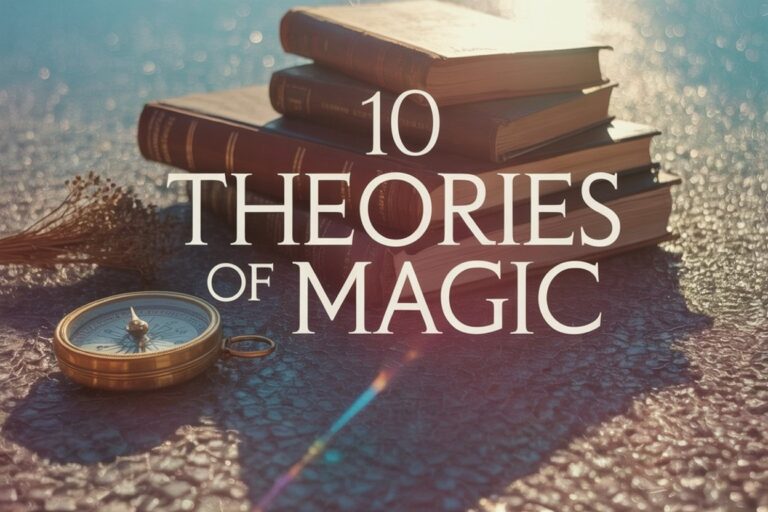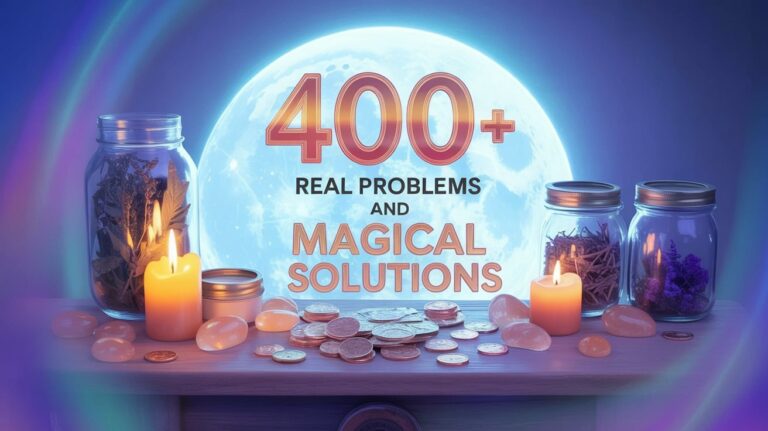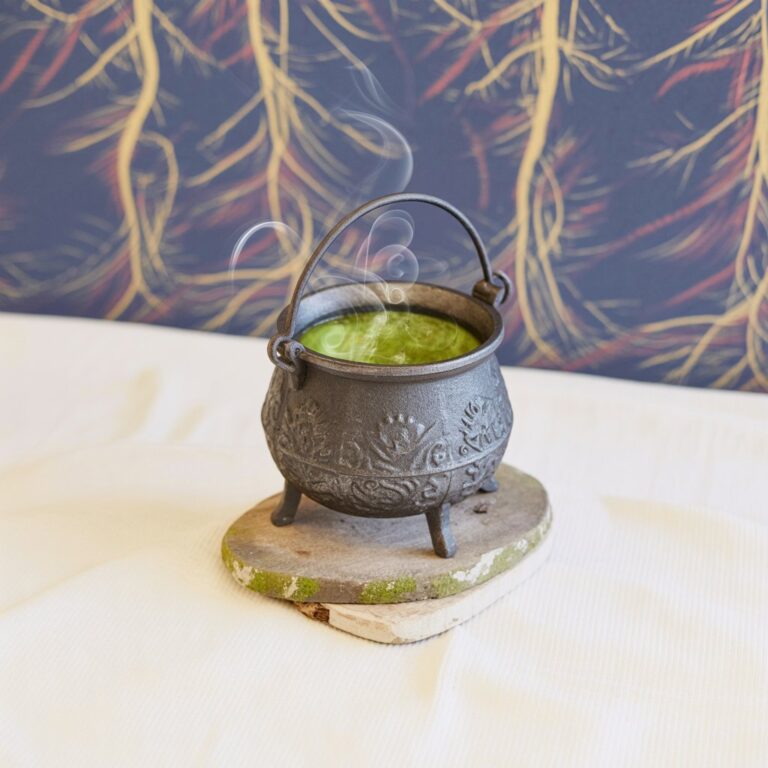Impulse or Intuition? 7 Essential Questions Before Spending Money on Witchcraft
Please note that posts on this site may contain affiliate links
Your hand hovers over that stunning crystal sphere in the metaphysical shop. Your heart says yes, but your bank account whispers no. How do you know if this purchase is genuine intuition or just an impulsive desire? This common dilemma affects practitioners at every stage of their witchcraft journey.
I’ve stood frozen in metaphysical shops countless times, caught between the magnetic pull of beautiful tools and the practical voice of my budget. After 20 years of practice, I’ve developed a system for determining whether a purchase truly serves my spiritual work or simply satisfies a momentary craving. The challenge lies in distingushing authentic spiritual guidance from clever marketing and our own psychological triggers.
The metaphysical market knows exactly how to target our spiritual aspirations. Sellers understand our desire for transformation, connection, and power. They strategically position products as gatekeepers to these experiences. This isn’t necessarily manipulative. Many shop owners genuinely believe in their products. However, awareness of these dynamics helps us make choices aligned with our true needs rather than manufactured desires.
Most witches struggle with three core tensions when considering magical purchases. First, the spiritual question: “Is this item calling to me for legitimate magical reasons?” Second, the psychological tension: “Am I buying this to fill an emotional need rather than a practical one?” Third, the material reality: “Can I truly afford this, and will it enhance my practice enough to justify the expense?”

Understanding the Psychology Behind Magical Purchases
Consumer psychology operates powerfully in spiritual marketplaces. Studies show we make emotional purchasing decisions and justify them rationally afterward. This becomes especially complex with magical items because we’re taught to trust our intuition and feelings.
The magical marketplace exploits this beautifully. Crystal descriptions promise emotional healing. Tarot decks claim to unlock hidden knowledge. Ritual tools supposedly enhance your power. These aren’t necessarily false claims. Many tools genuinely assist practice. The issue arises when we believe a specific purchase is necessary for spiritual progress.
Traditional witchcraft texts actually emphasize the practitioner’s power over tools. Many historical witches worked with found objects, household items, and natural materials. The abundance of specialized commercial products is relatively modern. This historical perspective provides helpful context for our consumer culture.
I notice patterns when teaching new practitioners. Those with fewer specialized tools often develop stronger foundational skills. They learn resourcefulness and personal power rather than dependency on specific items. Conversely, some students with extensive collections struggle to work effectively without their “perfect” tools.
Metaphysical marketing creates powerful associations between products and spiritual identity. The message becomes: “Real witches own these items.” This transforms ordinary consumer choices into statements about authenticity and belonging. Recognizing this pattern helps break its power over our decisions.
The most insidious aspect of spiritual marketing manipulates our desire for quick transformation. The promise that a crystal or charm will immediately solve problems appeals to our very human wish for easy solutions. Authentic practice requires consistent work. No purchase provides instant enlightenment.
(Overwhelmed? Light a virtual candle and take 5 minutes. It actually helps.)

The 7 Questions to Ask Before Buying
1. Does this serve a specific function in my current practice?
This question addresses practical utility versus aspirational acquisition. Consider your actual rituals and workings. Will this item fulfill a genuine need within these practices? If you’re primarily doing kitchen witchery but feel drawn to ceremonial magic tools, pause. Are you expanding your practice meaningfully or collecting for someday?
Example: A practitioner regularly works with herbs but never performs fire magic. Despite this, they feel drawn to an expensive handcrafted wand. Before purchasing, they should identify specific ways they’ll incorporate this tool into their practice.
2. How will this purchase impact my financial stability?
Magical practice should enhance your overall wellbeing, including financial health. Calculate the true cost beyond the price tag. Consider transportation to obtain it, protective containers, display options, or additional items needed to use it properly. Compare this total against your discretionary spending budget.
Example: A student witch feels called to purchase a $75 grimoire. After calculating additional costs for protective storage and special ink, the total reaches $120. This represents 25% of their monthly discretionary budget. They decide to start with a less expensive option that accomplishes the same purpose.
3. Do I have space to properly store and honor this item?
Magical items deserve respectful treatment. Cluttered, forgotten tools gather dust and negative energy rather than supporting your practice. Honestly assess your living situation. Do you have appropriate space to store this item properly? Will it compete with existing tools for your attention?
Example: A witch living in a small apartment feels drawn to purchase a large crystal grid set. Their current altar space is already crowded. Rather than adding more items, they decide to work with photography of crystal formations and occasional single specimens.

4. Have I wanted this consistently, or is this a sudden impulse?
Genuine intuitive guidance typically persists. It returns repeatedly, growing clearer over time. Impulses flash brightly then fade quickly. Track your desires for magical purchases. Items that consistently call to you over weeks or months more likely represent intuitive guidance than those that suddenly captivate you.
Example: A practitioner visits a metaphysical shop and feels immediately drawn to an expensive ritual knife they’ve never considered before. Instead of purchasing immediately, they take a photo and leave their contact information. Three weeks later, they still think about the knife daily and return to purchase it.
5. Does this item align with my authentic magical path?
Each practitioner develops unique approaches to witchcraft. Your purchases should reflect your personal path rather than generic expectations. Consider whether this item supports your specific interests, deities, spirits, or magical system. Beware of purchasing based on others’ practices or social media trends.
Example: A sea witch who works primarily with water energy feels compelled to buy a fire cauldron because many popular witches recommend it. After reflection, they realize this doesn’t align with their practice and instead invest in water-appropriate tools.
6. Can I create or substitute this with something I already have?
Resourcefulness has always been central to witchcraft. Historical practitioners worked with household items and natural materials. Before purchasing, consider whether you could create this tool yourself or repurpose something you already own. This approach often creates more personally meaningful items.
Example: Rather than buying expensive crystal points for protective grid work, a witch collects quartz from a local stream. The personal connection to these stones and the ritual of gathering them creates more powerful magic than purchasing commercial specimens would have.
7. How will this serve my practice one year from now?
Magical tools should have longevity. Consider whether this purchase will remain relevant as your practice evolves. Some items become stepping stones quickly outgrown. Others become lifelong companions. Neither is inherently bad, but understanding the expected lifespan helps evaluate the purchase’s value.
Example: A beginning practitioner considers an expensive beginner’s tarot deck with simplified imagery. After considering their serious interest in tarot, they decide to invest in a classic deck they can grow with for years instead.

A Simple 3-Card Tarot Spread for Purchase Clarity
When logical analysis still leaves you uncertain, this spread offers intuitive guidance about potential purchases:
Card 1: What draws me to this item?
Card 2: How will this serve my practice?
Card 3: What should I consider before deciding?
Interpret this spread with attention to both positive and challenging cards. Reversed cards or traditionally difficult cards don’t necessarily mean “don’t buy.” They might indicate important considerations or potential challenges to address.
If you don’t use tarot, substitute another divination method. Pendulums work well for yes/no questions about purchases. Rune pulls can reveal underlying motivations. Even bibliomancy (randomly selecting passages from books) can provide unexpected insights about potential acquisitions.
Budgeting Spells and Magical Money Management
Magical practice and financial responsibility can beautifully intertwine. This simple candle spell helps align your spending with your values:
- Select a green candle (unscented works best)
- Carve or write your current magical budget amount
- Anoint with mint oil or basil oil for clarity
- Light the candle and visualize your money flowing toward your highest magical priorities
- Let the candle burn completely (safely)
For ongoing magical budgeting, create a dedicated “witch savings jar.” Decorate it with symbols of abundance and discipline. Each time you resist an impulse purchase, place the saved money in this jar. When the jar fills, use it intentionally for a significant magical investment that truly serves your practice.
Connect financial decisions to your broader magical system. If you work with elemental energies, consider how purchases balance or imbalance these forces in your practice. Those working with deities might consult their guidance about significant acquisitions. This integration ensures your material choices reflect your spiritual values.
Conscious Consuming in Metaphysical Spaces
Metaphysical shops create environments designed to stimulate purchasing. Beautiful displays, ambient music, and aromatic incense bypass rational thought and activate emotional and spiritual receptivity. This isn’t inherently problematic, but awareness helps maintain boundaries.
When entering these spaces, ground yourself first. Take three deep breaths outside the shop. Set a clear intention and, if helpful, a specific budget. Some practitioners carry a protective stone like black tourmaline to maintain energetic boundaries against environmental influences.
Ask thoughtful questions before purchasing. Ethical shop owners welcome inquiries about sourcing, particularly for items like white sage, palo santo, or crystals with complex mining issues. Their responses reveal much about their business practices and values.
Create a personal waiting period for unplanned purchases over a certain amount. Take photos of items that call to you. Write down their information and your feelings about them. Return home and sit with the desire for at least a week. Items truly meant for your practice will maintain their appeal beyond the shop’s atmospheric influence.
If You’ve Already Overspent: Magical Damage Control
Many practitioners have faced the morning-after regret of magical overspending. Rather than shame, approach this as an opportunity for shadow work. Examine what needs or insecurities drove the purchases. Journal about what you hoped these items would provide emotionally or spiritually.
Create a reconsecration ritual for underused purchases. This involves honestly assessing each item, cleansing it energetically, and either recommitting to its use or releasing it. For items you choose to release, consider selling on witch-friendly platforms, trading with community members, or donating to newer practitioners.
Transform buyer’s remorse into productive energy with this simple ritual: Write your feelings about the purchase on a bay leaf. Burn it safely while stating: “I transform regret into wisdom. These lessons serve my highest good.” Use the resulting energy to make a concrete financial plan for future magical spending.
Remember that magical items find their way to those who need them. If you purchased something not truly aligned with your practice, it might be meant to pass through your hands to someone else. Releasing it becomes part of its magical journey rather than a mistake.
Developing Your Personal Discernment System
The ultimate goal isn’t perfect purchasing decisions but developing your own discernment system. Create a personal ritual you perform before significant magical acquisitions. This might involve meditation, divination, budgeting considerations, or consultation with trusted community members.
I’ve learned that my most powerful magical tools often come through unexpected channels. The gifted feather, the inherited book, the stone that simply appeared on my path. These carry energy no purchased item can match. Remaining open to these synchronicities sometimes means keeping resources free rather than tying them up in commercial acquisitions.
The relationship between witchcraft and consumerism remains complex and personal. Some traditions require specific tools while others emphasize the witch as the primary instrument of magic. Your path will reveal which approach serves your practice best. Trust this unfolding wisdom more than any external authority about what you “should” own.
Remember that magical growth comes through practice, not possessions. The most powerful witches throughout history worked with whatever tools were available to them. Your magic resides in you, not your shopping cart.

Easy Simmer Pot Recipes for Financial Abundance Using Herbal Witchcraft
Unlock prosperity and attract wealth with ‘Easy Simmer Pot Recipes for Financial Abundance Using Herbal Witchcraft‘ for just $3.99—transform your life with potent, magical simmer pot spells.






